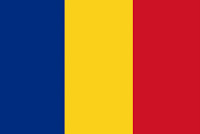As messy histories of the region go, Romania is right up there having been carved up, shared out, and lost and won by Empires throughout its history. And yet it started so well against the Romans.
Not for the tribes of the region a straightforward subjugation to Roman rule. It took decades of fighting for the Romans to get a foothold north of the Danube in what is now central Romania (think Decebalus, Trajan, his bridge across the Danube and his road through the Iron Gates gorges) only to decide to withdraw again over a century later because it proved difficult to defend. A period of migration into the area from across northern and eastern Europe then shaped the region, leading up to the formation of the First Bulgarian Empire of which current Romanian lands were a part.
As the Bulgarian Empire declined, Latin speakers ('Romanians') were hemmed in by the Bulgarian Empire to the south and Hungary to the north; travelling through the country it becomes obvious that this is an enclave of people with a Latin based language (Italian helps here) surrounded by nations with Slavic languages. They carved out a region that developed into the semi-autonomous Hungarian states of Wallachia, Moldavia and - yes - Transylvania. It is in these states that we see the outline of the modern Romania developing. Wallachia was to win its independence from Hungary only to later fall to Ottoman influence. And it is here that the Wallachian ruler Vlad Dracula, or Vlad the Impaler, makes an appearance with his successes against, and cruelty to, the Ottomans becoming legendary across Europe.
Eventually all three states fell under Ottoman influence until a period of conflict between the Ottoman and Russian, and the Ottoman and Austrian Empires carved them up still further. But by now it was the 1800s and Empire was past its zenith and nationalism was on the rise with the Romanian speaking people seeking an independent nation formed from their three historic states. Wallachia and Moldavia gained independence from the Ottomans after fighting alongside the Russians in the Russo-Turkish War of 1877-78 and they united to form the core of the new Romanian state. Unfortunately, by this time the Hungarian crown had gained control of Transylvania and it would not be until after the First World War that this final state would be absorbed into what became Greater Romania.
As the Second World War ended Romania was occupied by Russia and subsequently fell under control of the Soviet Union. The 1970s saw the country under the totalitarian leadership of the infamous Nicolae Ceausescu with a government noted for its political repression and poor economic performance. The 1989 Romanian Revolution saw his fall and the beginnings of the modern EU state we see today.
 |
| Modern Romania |




No comments:
Post a Comment